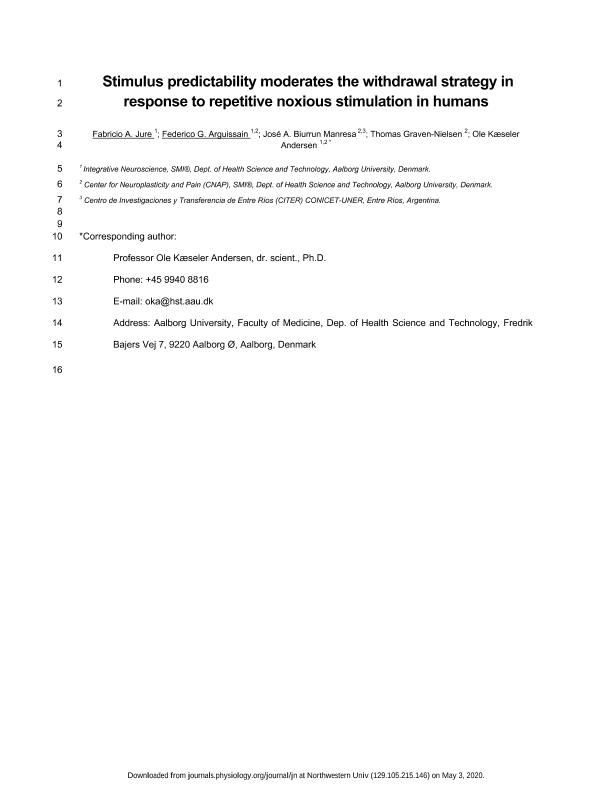Mostrar el registro sencillo del ítem
dc.contributor.author
Jure, Fabricio A.
dc.contributor.author
Arguissain, Federico G.
dc.contributor.author
Biurrun Manresa, José Alberto

dc.contributor.author
Graven Nielsen, Thomas
dc.contributor.author
Andersen, Ole Kæseler
dc.date.available
2021-10-06T18:49:22Z
dc.date.issued
2020-06
dc.identifier.citation
Jure, Fabricio A.; Arguissain, Federico G.; Biurrun Manresa, José Alberto; Graven Nielsen, Thomas; Andersen, Ole Kæseler; Stimulus predictability moderates the withdrawal strategy in response to repetitive noxious stimulation in humans; American Physiological Society; Journal of Neurophysiology; 123; 6; 6-2020; 2201-2208
dc.identifier.issn
0022-3077
dc.identifier.uri
http://hdl.handle.net/11336/142934
dc.description.abstract
Nociceptive withdrawal reflex (NWR) is a protective reaction to a noxious stimulus, resulting in withdrawal of the affected area and thus preventing potential tissue damage. This involuntary reaction consists of neural circuits, biomechanical strategies, and muscle activity that ensure an optimal withdrawal. Studies of lower limb NWR indicate that the amplitude of the NWR is highly modulated by extrinsic and intrinsic factors, such as stimulation site, intensity, frequency, and supraspinal activity, among others. Whether the predictability of the stimulus has an effect on the biomechanical strategies is still unclear. This study aimed to evaluate how the predictability of impending noxious stimuli modulate the NWR reaction in the lower limb. NWR was evoked on fifteen healthy participants by trains of electrical stimuli on the sole of the foot and was measured in one distal (tibialis anterior) and one proximal (biceps femoris) muscle. The predictability was manipulated by giving participants prior information about the onset of the stimulus trains and the number of delivered stimuli per train. Results showed that the predictability of the incoming stimuli differentially modulates the muscle activity involved in the NWR reaction. For the most unpredictable stimulus train, larger NWR at distal muscles were evoked. Furthermore, the stereotyped temporal summation profile to repeated stimulation was observed when the stimulus train was completely predictable, while it was disrupted in proximal muscles in unpredictable conditions. It is inferred that the reflex response is shaped by descending control, which dynamically tunes the activity of the muscles involved in the resulting reaction. NEW & NOTEWORTHY Innate defensive behaviors such as reflexes are found across all species, constituting preprogrammed responses to external threats that are not anticipated. Previous studies indicated that the excitability of the reflex arcs like spinal nociceptive withdrawal reflex (NWR) pathways in humans are modulated by several cognitive factors. This study assesses how the predictability of a threat affects the biomechanical pattern of the withdrawal response, showing that distal and proximal muscles are differentially modulated by descending control.
dc.format
application/pdf
dc.language.iso
eng
dc.publisher
American Physiological Society

dc.rights
info:eu-repo/semantics/openAccess
dc.rights.uri
https://creativecommons.org/licenses/by-nc-sa/2.5/ar/
dc.subject
DEFENSIVE BEHAVIOR
dc.subject
DESCENDING MODULATION
dc.subject
NOCICEPTIVE WITHDRAWAL REFLEX
dc.subject
PREDICTABILITY
dc.subject
TEMPORAL SUMMATION
dc.subject.classification
Ingeniería Médica

dc.subject.classification
Ingeniería Médica

dc.subject.classification
INGENIERÍAS Y TECNOLOGÍAS

dc.title
Stimulus predictability moderates the withdrawal strategy in response to repetitive noxious stimulation in humans
dc.type
info:eu-repo/semantics/article
dc.type
info:ar-repo/semantics/artículo
dc.type
info:eu-repo/semantics/publishedVersion
dc.date.updated
2021-09-07T14:09:16Z
dc.journal.volume
123
dc.journal.number
6
dc.journal.pagination
2201-2208
dc.journal.pais
Estados Unidos

dc.journal.ciudad
Bethesda
dc.description.fil
Fil: Jure, Fabricio A.. Aalborg University; Dinamarca
dc.description.fil
Fil: Arguissain, Federico G.. Aalborg University; Dinamarca
dc.description.fil
Fil: Biurrun Manresa, José Alberto. Universidad Nacional de Entre Ríos. Instituto de Investigación y Desarrollo en Bioingeniería y Bioinformática - Consejo Nacional de Investigaciones Científicas y Técnicas. Centro Científico Tecnológico Conicet - Santa Fe. Instituto de Investigación y Desarrollo en Bioingeniería y Bioinformática; Argentina. Consejo Nacional de Investigaciones Científicas y Técnicas. Centro de Investigaciones y Transferencia de Entre Ríos. Universidad Nacional de Entre Ríos. Centro de Investigaciones y Transferencia de Entre Ríos; Argentina. Aalborg University; Dinamarca
dc.description.fil
Fil: Graven Nielsen, Thomas. Aalborg University; Dinamarca
dc.description.fil
Fil: Andersen, Ole Kæseler. Aalborg University; Dinamarca
dc.journal.title
Journal of Neurophysiology

dc.relation.alternativeid
info:eu-repo/semantics/altIdentifier/url/https://journals.physiology.org/doi/10.1152/jn.00028.2020
dc.relation.alternativeid
info:eu-repo/semantics/altIdentifier/doi/http://dx.doi.org/10.1152/jn.00028.2020
Archivos asociados
